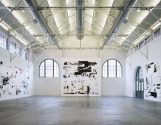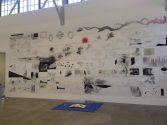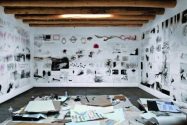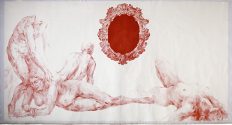Press & Media
“James Drake: Anatomy of Drawing and Space (Brain Trash),” Blanton Museum of Art
The Blanton Museum of Art at The University of Texas at Austin presents an immersive exhibition of works by virtuosic draftsman James Drake.
“Artist unloads ‘Brain Trash’ at MCASD,” The San Diego Union-Tribune
In spending more than two years making 1,242 drawings, artist James Drake learned a thing or two. “Believe it or not,” said the genial, Texas-born artist as he oversaw the installation of his new exhibition at the Museum of Contemporary Art San Diego, “I learned that less is more.”
James Drake: Anatomy of Drawing and Space (Brain Trash) at MCASD
James Drake: Anatomy of Drawing and Space (Brain Trash) at the Museum of Contemporary Art San Diego – July 10 through September 21, 2014
“James Drake: Anatomy of Drawing and Space (Brain Trash),” Museum of Contemporary Art San Diego
James Drake: Anatomy of Drawing and Space (Brain Trash) is the culmination of two years of active creation, reflecting imagery from throughout the artist’s forty-year career. In 2012, the artist committed himself to drawing every day.
“Gallery Walk,” New Orleans Art Review
Over at Arthur Roger Gallery, the red pastel figure drawings and glass sculptures of New Mexico-based James Drake’s “Can We Know the Sound of Forgiveness” and the multidimensional poured paintings of Holton Rower ‘s “Viscous Resin Extruding From the Trunk” evoke styles of the past.
“James Drake: Salon of a Thousand Souls,” THE Magazine
HOW TO ADDRESS GREATNESS? I find it surprisingly difficult to write about an exhibition by an artist whom I greatly admire – James Drake, in this case, and his show of works from the 1980s through the present. Salon of a Thousand Souls was so intelligently presented by curator of contemporary art Laura Addison (with the artist’s input) that I fear anything I might add would appear as the slobbering gibber of a sycophant. I am reduced, therefore, to description, with the endorsement that you go see the exhibition, stat.
“Soul Man,” Journal North
All artists build imaginary spaces. James Drake is fully cognizant of the human tendency to project subjective history and meanings into the spaces he opens and constructs. Even before the visitor reaches the formal entry of his current exhibition at the New Mexico Museum of Art, the artist has placed three functional steel sculptures that announce his personal point of view. These include two benches and a graceful child’s table stacked with books of art and literature that are meaningful to him. There are monographs on Goya, Daumier, Rubens, the Mexican muralists, the novel “Blood Meridian” by Cormac McCarthy, two books of poetry by Jimmy Santiago Baca, including “Que Linda la Brisa” (2001) with photographs by Drake, and the 2008 University of Texas survey of the artist’s 35-year career.
“Party of 36 (plus 1 Serpent),” The New York Times
One winter morning in 2001, the artist James Drake was sitting over coffee with the novelist Cormac McCarthy. They were at one of their regular haunts in Santa Fe, N.M., where they both live, chatting about work and family, the kinds of things said idly that lead to other thoughts.
“The Art of Allusion and Illusion,” New Orleans Art Review
Shifting gears, in James Drake’s grand baroque theater drawing, Dancing in the Louvre, the elegantly simulated moldings mediate the viewer’s imaginative transgression of the proscenium plane. The gown that overflows into the foreground space, the dynamic diagonal and counterpoint of the dancers’ elegantly dressed forms, and the two point perspective defined by the pedestal at the left and the voyeur couple on the right serves to establish a continuum from the viewer’s real world space through the fore,
middle, and implied distance.







